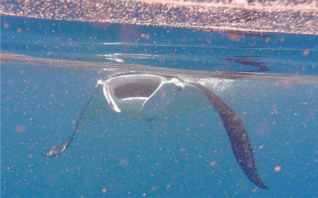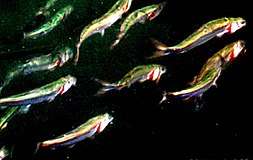Aquatic feeding mechanisms

Aquatic feeding mechanisms face a special difficulty as compared to feeding on land, because the density of water is about the same as that of the prey, so the prey tends to be pushed away when the mouth is closed. This problem was first identified by Robert McNeill Alexander.[1] As a result, underwater predators, especially bony fish, have evolved a number of specialized feeding mechanisms, such as filter feeding, ram feeding, suction feeding, protrusion, and pivot feeding.
Most underwater predators combine more than one of these basic principles. For example, a typical generalized predator, such as the cod, combines suction with some amount of protrusion and pivot feeding.
Suction feeding
|
|
Suction feeding is a method of ingesting a prey item in fluids by sucking the prey into the predator's mouth. This is typically accomplished by the predator expanding the volume of its oral cavity and/or throat, resulting in a pressure difference between the inside of the mouth and the outside environment. When the mouth is opened, the pressure difference causes water to flow into the predator's mouth, carrying the prey item in with the fluid flow.[2]
Though suction feeding can be seen across fish species, those with more derived characters show an increase in the suction force as a result of more complex skull linkages that allow greater expansion of the buccal cavity and thereby creating a greater negative pressure. Most commonly this is achieved by increasing the lateral expansion of the skull. In addition, the derived character of upper jaw protrusion is acknowledged to increase the force exerted on the prey to be engulfed.[3] Perhaps the best examples of these derived characters that are explained belong to fishes in the teleostei clade.[4] However, a common misconception of these fishes is that suction feeding is the only or primary method employed.[5] In Micropterus salmoides ram feeding is the primary method for prey capture; however, they can modulate between the two methods or use both as with many teleosts.[6][5] Also, it is commonly thought that fishes belonging to more primitive clades exhibit suction feeding. Although suction may be created upon the mouth opening in such fishes, the criteria for suction feeding includes little or no bodily movement towards their prey.[4]
Ram feeding

Ram feeding, also known as lunge feeding, is a method of feeding underwater in which the predator moves forward with its mouth open, engulfing the prey along with the water surrounding it. During ram feeding, the prey remains fixed in space, and the predator moves its jaws past the prey to capture it. The motion of the head may induce a bow wave in the fluid which pushes the prey away from the jaws, but this can be avoided by allowing water to flow through the jaw. This can be accomplished by means of an expandable throat, as in snapping turtles and baleen whales,[8] or by allowing water to flow out through the gills, as in sharks and herring. A number of species have evolved narrow snouts, as in gar fish and water snakes .[9]
Herrings often hunt copepods. If they encounter copepods schooling in high concentrations, the herrings switch to ram feeding. They swim with their mouth wide open and their opercula fully expanded. Every several feet, they close and clean their gill rakers for a few milliseconds (filter feeding). The fish all open their mouths and opercula wide at the same time (the red gills are visible in the photo below—click to enlarge). The fish swim in a grid where the distance between them is the same as the jump length of the copepods.
Lunge feeding
Baleen whales feed on plankton by a technique called lunge feeding. Lunge feeding could be regarded as a kind of inverted suction feeding, during which a whale takes a huge gulp of water, which is then filtered through the baleens.[10] Biomechanically this is a unique and extreme feeding method, for which the animal at first must accelerate to gain enough momentum to fold its elastic throat (buccal cavity) around the volume of water to be swallowed.[11] Subsequently, the water flows back through the baleens keeping back the food particles. The highly elastic and muscular buccal rills are a specialized adaptation to this feeding mode.
Pivot feeding
Pivot feeding is a method to transport the mouth towards the prey by an upward turning of the head, which is pivoting on the neck joint. Pipefish such as sea horses and sea dragons are specialized on this feeding mechanism.[14] With prey capture times of down to 5 ms (shrimpfish Centriscus scutatus) this method is used by the fastest feeders in the animal kingdom.
The secret of the speed of pivot feeding is in a locking mechanism, in which the hyoid arch is folded under the head and is aligned with the urohyal which connects to the shoulder girdle. A four-bar linkage at first locks the head in a ventrally bent position by the alignment of two bars. The release of the locking mechanism jets the head up and moves the mouth toward the prey within 5-10 ms. The trigger mechanism of unlocking is debated, but is probably in lateral adduction.
Protrusion
|
|
Protrusion is the extension of the mouth or premaxilla towards the prey, via mechanical linkages. Protrusion is known only in modern bony fishes, which possess many forms of coupled linkages in their head.[15] Remarkable examples are the slingjaw wrasse and the sand eel, which can protrude their mouth by several centimeters. Another example of protrusion is seen in dragonfly larvae (nymphs), which have hydraulic lower mandibles, protruding forward to catch prey and bring it to the top jaw.[16]
Filter and suspension feeding

This is the selection of food particles from a water flow, for example by the gill rakers of fish, the baleens of whales, or the ostia of sponges.
Filter feeding
In filter feeding, the water flow is primarily generated by the organism itself, for example by creating a pressure, by active swimming, or by ciliary movements.
Suspension feeding
In suspension feeding, the water flow is primarily external or if the particles themselves move with respect to the ambient water, such as in sea lilies.
See also
References
- ↑ Alexander, R. McN. 1967. Functional design in fishes. London, UK: Hutchinson University Library.
- ↑ Lauder, George (1980). "The suction feeding mechanism in sunfish (Lepomis): an experimental analysis" (PDF). Journal of Experimental Biology: 49–72.
- ↑ Holzman, R., Day, S. W., Mehta, R. S., & Wainwright, P. C. (2008). "Jaw protrusion enhances forces exerted on prey by suction feeding fishes". Journal of the Royal Society Interface: 1445–1457. doi:10.1098/rsif.2008.0159. PMC 2607355.
- 1 2 Lauder, George (1982). "Patterns of evolution in the feeding mechanism of actinopterygian fishes". American Zoologist: 275–285. doi:10.1093/icb/22.2.275.
- 1 2 Gardiner, J. M., & Motta, P. J. (2012). "Largemouth bass (micropterus salmoides) switch feeding modalities in response to sensory deprivation". Zoology (Jena, Germany): 78–83.
- ↑ Norton, S. F., & Brainerd, E. L. (1993). "Convergence in the feeding mechanics of ecomorphologically similar species in the centrarchidae and cichlidae". Journal of Experimental Biology.
- ↑ Jaine, FRA; Couturier, LIE; Weeks, SJ; Townsend, KA; Bennett, MB; Fiora, K; Richardson, AJ (2012). "When Giants Turn Up: Sighting Trends, Environmental Influences and Habitat Use of the Manta Ray Manta alfredi at a Coral Reef". PLOS ONE. 7: e46170. doi:10.1371/journal.pone.0046170. PMC 3463571. PMID 23056255.
- ↑ Goldbogen, J. A.; Calambokidis, J.; Shadwick, R. E.; Oleson, E. M.; McDonald, M. A.; Hildebrand, J. A. (2006). "Kinematics of foraging dives and lunge-feeding in fin whales". J. Exp. Biol. 209: 1231–1244. doi:10.1242/jeb.02135.
- ↑ Van Wassenbergh, S., Brecko, J., Aerts, P., Stouten, I., Vanheusden, G., Camp, A., Van Damme, R., and Herrel, A. (2010). Hydrodynamic constraints on prey-capture performance in forward-striking snakes. J. Roy. Soc. Interface, 7:773-785
- ↑ Goldbogen, JA; Calambokidis, J; Shadwick, RE; Oleson, EM; McDonald, MA; Hildebrand, J A (2006). "Kinematics of foraging dives and lunge-feeding in fin whales" (PDF). Journal of Experimental Biology. 209: 1231–1244. doi:10.1242/jeb.02135.
- ↑ Potvin, J; Goldbogen, JA (2009). "Passive versus active engulfment: verdict from trajectory simulations of lunge-feeding fin whales Balaenoptera physalus". J. R. Soc. Interface. 6 (40): 1005–1025. doi:10.1098/rsif.2008.0492. PMC 2827442. PMID 19158011.
- ↑ Langley, Liz (26 November 2013). "Why Does the Seahorse Have Its Odd Head? Mystery Solved – News Watch". Newswatch.nationalgeographic.com.
- ↑ Gemmell, B. J.; Sheng, J.; Buskey, E. J. (2013). "Morphology of seahorse head hydrodynamically aids in capture of evasive prey". Nature Communications. 4: 2840. doi:10.1038/ncomms3840. PMID 24281430.
- ↑ de Lussanet, M. H. E.; Muller, M. (2007). "The smaller your mouth, the longer your snout: predicting the snout length of Syngnathus acus, Centriscus scutatus and other pipette feeders". J. R. Soc. Interface. 4: 561–573. doi:10.1098/rsif.2006.0201. PMC 2373409.
- ↑ Muller, M (1996). "A novel classification of planar four-bar linkages and its application to the mechanical analysis of animal systems". Phil. Trans. R. Soc. Lond. B. 351: 689–720. doi:10.1098/rstb.1996.0065.
- ↑ io9. io9 http://io9.com/how-is-this-dragonflys-prehensile-mouthpart-connected-t-1658069078. Missing or empty
|title=(help)
External links
- FishBase is a comprehensive database of bony fishes: /fishbase.org



